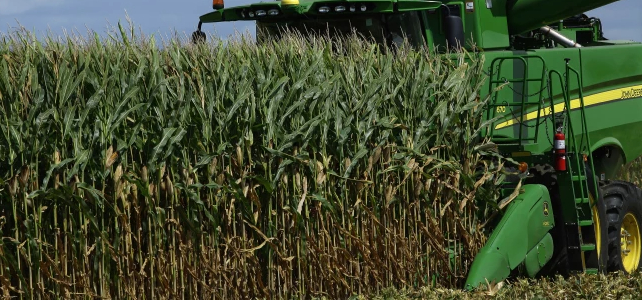November 22, 2025 | 17:31 GMT +7
November 22, 2025 | 17:31 GMT +7
Hotline: 0913.378.918
November 22, 2025 | 17:31 GMT +7
Hotline: 0913.378.918

A central Illinois corn farmer begins to harvest this years crops of corn in Pleasant Plains, Ill. Wet, cool conditions across much of Illinois have put farmers behind schedule in bringing their corn in from the fields, according to the U.S. Department of Agriculture. Photo: AP/Seth Perlman
Russia previously accounted for 15% of U.S. fertilizer imports.
"We have heard that some farmers have balked at buying at the high prices and have not filled their needs, hoping prices will go down," Nebraska farmer John Dittrich, who grows both corn and soybeans, told MarketWatch.
Prices for some types of fertilizer cost a record $1,520 per ton, an increase of 127% this year. Corn is up 4%, at nearly $7.67 per bushel. As a result, 4 million fewer acres of corn will be planted, while soybean crops will increase by the same amount, MarketWatch reported.
Soybeans put nitrogen back into the ground rather than extract it, so they only need a small amount of fertilizer when compared to corn. Previously, the average farmer used 255 pounds of fertilizer for corn, compared to 65 pounds for soybeans, Bloomberg reported.
But fertilizer is just one part of the equation when it comes to rising food prices. Farmers have also endured rising costs for livestock feed, fuel, machine parts, and herbicide.
To make matters worse the Midwest is experiencing drought-like conditions that yield poor crops.
“It feels like going down the hill in a truck and picking up speed but not being sure if you can make that corner at the bottom,” Iowa farmer John Gilbert said of the numerous calamities that growers are enduring.
Chicago soybeans fall further on record US acreage forecast
Chicago soybeans fell for a second day on Friday to hit a one-month low after a U.S. Department of Agriculture (USDA) forecast of record U.S. soy acreage pressured the market. Corn was little changed after the previous day’s rise as the market weighed the USDA’s lower-than-expected projection of U.S. corn planting against weakness in crude oil.
Wheat rose, helped by a lower-than-expected USDA estimate of spring wheat seedings and uncertainty over the course of the conflict between Russia and Ukraine, both major grain exporters.
The most active soybean contract on the Chicago Board of Trade (CBOT) was down 0.6% at $16.09 per bushel by 1112 GMT. It earlier hit its lowest since February 25 but held above the $16 chart threshold. The USDA projected that U.S. farmers would plant the most soybean acres on record this spring while reducing corn acreage to a level below a range of analyst estimates.
"The pronounced shift in acreage from corn to soybeans is probably due to the sharp rise in fertilizer prices," Commerzbank said.
Soybeans require less fertilizer than corn, making the oilseed more attractive to farmers as high costs and tight supply of fertilizer have been exacerbated by the conflict in Ukraine. Soybeans also faced pressure from a slide in crude oil on Thursday after the United States announced a record release of its strategic oil reserves to curb high fuel prices. The slide in crude oil also capped corn prices. Like soybean oil, corn is widely used in biofuels. Crude was little changed on Friday ahead of a meeting of consuming nations. CBOT corn edged down 0.3% to $7.46¾ a bushel after adding more than 1% on Thursday.
CBOT wheat rose 2.2% to $10.27¾ a bushel, helped by strength in MGEX spring wheat futures after the USDA’s acreage report. A separate USDA estimate of U.S. quarterly wheat stocks at a 14-year low also underpinned the cereal market. Following losses earlier this week, market participants were also adjusting positions in wheat before the weekend, with developments in the Ukraine war unclear, traders said.
Prices at 1112 GMT Last Change Pct End Ytd Pct Move 2021 Move CBOT wheat 1027.75 21.75 2.16 770.75 33.34 CBOT corn 746.75 -2.00 -0.27 593.25 25.87 CBOT soy 1609.00 -9.25 -0.57 1339.25 20.14 Paris wheat 370.00 0.50 0.14 276.75 33.69 Paris maize 323.00 0.25 0.08 226.00 42.92 Paris rape 931.75 -9.25 -0.98 754.00 23.57 WTI crude oil 100.16 -0.12 -0.12 75.21 33.17 Euro/dlr 1.11 0.00 -0.07 1.1368 -2.74 Most active contracts - Wheat, corn and soy US cents/bushel, Paris futures in euros per tonne.
(Washingtonexaminer; Reuters)

(VAN) In a new study published in Trends in Biotechnology, researchers used a gene-editing technology called CRISPR to increase a fungus's production efficiency and cut its production-related environmental impact by as much as 61%- all without adding any foreign DNA.

(VAN) A top official in Beijing’s Cop delegation says China is committed to clean energy – but US’s absence is a problem.

(VAN) The Bangsamoro region’s inflation rate rose slightly to –1.3 percent in October 2025 from –1.5 percent in September, the Philippine Statistics Authority (PSA-BARMM) reported.

(VAN) FAO-led report says protecting and restoring forests is crucial to boosting climate-resilient agriculture, rural livelihoods and global food and water security.

(VAN) Flagship partnership secures additional GBP 16.9 million to strengthen forest monitoring, transparency and country support to 2030.

(VAN) After a turbulent year for international development, the aid and assistance landscape has shifted, with donors rethinking how, where and why they support sustainable development.

(VAN) A new tool for measuring the economic value of farm animal welfare improvements has been developed, potentially transforming how consumers, retailers and the government evaluate animal welfare policies.